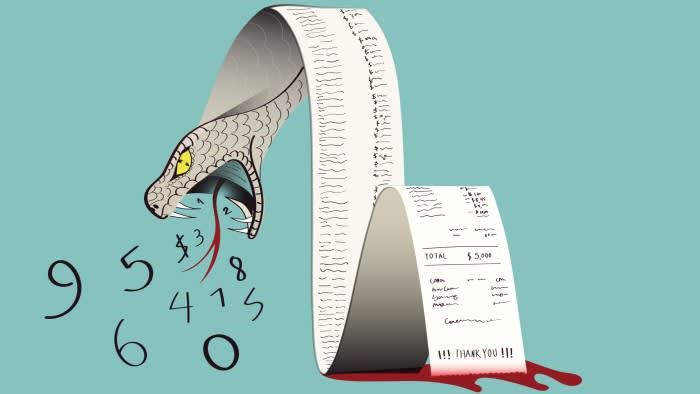
Unlock the Editor’s Digest for free
Roula Khalaf, Editor of the FT, selects her favourite stories in this weekly newsletter.
What can be done to cut inflation? That is a question haunting central bankers right now, given the “disappointing” trajectory of consumer price data in America, among other places.
It is also worrying politicians such as US President Joe Biden, against a backdrop of a high level of voter discontent about the economy. Investors are uneasy too. This week the gold price hit record highs, amid a search for inflation hedges.
This is, in turn, prompting some classic policy responses: on the one hand, the Federal Reserve is pledging to keep rates high to curb demand; on the other, Biden is lashing out against big business for alleged “price gouging” and/or deceptive practices such as “shrinkflation”, or selling fewer goods for the same price.
Cue a recent bizarre spat about the size of a Snickers bar. Biden suggested in his State of the Union speech that these have shrunk; Mars, the maker of Snickers, denies that.
This war of words makes for colourful debate. But as the Fed’s headache deepens, there is a far better way to frame the issue — by invoking what economists call “shrouding”. The term refers to the way prices are presented to, and concealed from, consumers, and has been widely studied by behavioural economists.
Back in the 1980s, for example, the late Daniel Kahneman worked with Amos Tversky to explore “price partitioning”, or how companies sometimes price products in multiple steps, making it hard for consumers to evaluate costs in a “rational” manner.
Hotel rooms are one example from the service sector: a low initial charge might carry subsequent high additional fees. Printers are another: a cheap printing device might require expensive ink cartridges, the cost of which are not readily visible upfront. Shipping costs are yet another example.
A cynic might shrug at this, and argue that it is just sensible behaviour on the part of profit-seeking companies. Maybe so. Consultants such as Deloitte have offered advice to their clients in recent years about how far companies can use shrouding to raise margins, without sparking a consumer backlash. But the mere fact that shrouding still exists in 2024, four decades after Kahneman and others began studying it, underscores three important points.
First, business competition does not always deliver true efficiency; markets can fail. Second, this market failure arises because consumers are not the all-knowing rational agents that they appear in economic models. They have cognitive biases that lead them to make poor choices and leave them ill-equipped to make judgments about inflation.
And third, digitisation alone does not magically fix these competition problems. Yes, it can create more price transparency in some arenas, such as airline tickets. But the internet sometimes creates so much information overload that it can also lead to shrouding, particularly when consumers are busy or poorly educated. Indeed, the image — or illusion — of online transparency can actually make obfuscation worse.
Measuring the cost of this is hard, of course. But last month the London-based Behavioural Insights Team had a stab at it, and concluded that British gross domestic product would be 0.2 to 1 per cent (or £5-£23bn) bigger if shrouding did not exist.
It arrived at that estimate by assuming that true price transparency would enable consumers to buy products and services from more efficient companies, thus raising productivity. However, it also explored another crucial issue: that one of the biggest victims of shrouding is the government, since officials running public procurement programmes also struggle to judge the true cost of the services they acquire.
It follows that efficiency and efficacy would rise for the public and private sectors alike if there were anti-shrouding policies. These could include measures to impose standardised labelling for products and support price comparison websites, consumer advisory services and so on.
Some free-market economists will undoubtedly wince at this and see it as unwarranted meddling, although BIT says such measures would simply “improv[e] how markets work, unleash innovation and creativity, and help people to make better choices for themselves”.
Either way, American policymakers and pundits should heed this kind of research. After all, Biden is not the only politician wailing about inflation and alleged price gouging. Donald Trump, the presumptive Republican presidential nominee, has expressed similar sentiments in the past.
That is unsurprising, given that bashing big business is often a vote-winner. However, it would be preferable for policymakers to find practical ways to support better price transparency, rather than terrorising the C-suite. The latter hurts confidence, while the former might actually improve competition and market functioning in ways that reduce prices.
To put it another way: if Washington wants to make sense of price trends, it needs to take a leaf out of Kahneman’s book and recognise that the perversity of human behaviour endures even in a digital world. That might not be enough to end those Snickers wars. But it would at least lead to a vision of economics more in tune with how companies, consumers and voters actually behave.
Read More: World News | Entertainment News | Celeb News
FT










